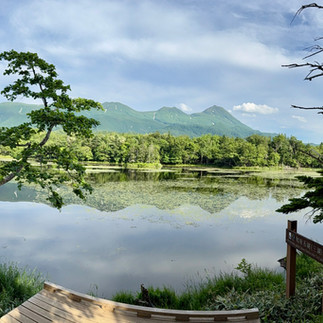Shiretoko: to the end of the earth and back
- Evangelia Papoutsaki
- Jun 28
- 3 min read
Did I say Hokkaido is the land of magical lakes? It truly is! From Lake Akan, I traveled north to the Shiretoko UNESCO World Natural Heritage Site and National Park, where I entered an enchanted realm of lakes. The name "Shiretoko" comes from the Ainu words “sir etok”, meaning “the end of the earth.” What a place!
I was incredibly lucky to have Sachi, my local guide, who took me to hidden spots only locals know—like a secluded water shrine, an open-air café in the forest serving Vietnamese coffee, and even hosted me in her countryside home near a local onsen. She insisted I try the onsen, and though the water was scalding with a thick mineral consistency—like burning silk—it did the trick! Before waving goodby at the train station, she insisted I stopped in Abashiri to visit the Museum of the Northen People, and I am so glad I did!
There’s a story behind how I met Sachi https://www.sachieasthokkaido.com. I had been searching for an Ainu guide after reading an academic article about how an Ainu association fought for Ainu guide training opportunities in Shiretoko. The UNESCO designation failed to acknowledge this as traditional Ainu land because the Japanese government claimed no Ainu lived there anymore—ignoring the dozens of sacred Ainu sites in the forest. In reality, settlers had displaced the Ainu, converting their land into industrial-scale farms. I was told that when the settlers arrived the forests were so thick and tall that they couldn't see the Mountain Shiretoko that is now visible from anywhere in the converted farmlands in the area.
The only Ainu-run lodging is a guesthouse in Utoro, the gateway to the national park, but booking was difficult since they only accept phone reservations. Many international visitors miss out on staying at this lovely guesthouse, which has a fantastic natural onsen.
To make a long story short, I emailed the natural guided tour site to book their Ainu guide, only to learn that person no longer worked there. (They really should have taken down the page advertising Ainu nature tours—but that’s another issue.) Thankfully, a colleague at the university connected me through her network to Sachi, a guide who incorporates Ainu cultural knowledge into her tours. Though not Ainu herself, Sachi is learning the language and makes an effort to share Ainu place names and their meanings. When I stayed with her, she showed me her nature guide training materials—which, disappointingly, dedicated just three pages to the Ainu.
At the visitor center, I was asked to participate in an interview for a Finnish researcher studying visitor engagement with conservation efforts at the UNESCO site. Of course, I said yes—I was thrilled to be on the receiving end of research like mine! I didn’t hold back: What kind of engagement is possible when the Ainu Mosir isn’t involved? What a missed opportunity to teach visitors about indigenous sustainable practices! The national park tours barely mentioned the Ainu, and most tourists had no idea who they were—let alone their deep connection to nature. Guides claimed tourists weren’t interested, but how could they be if they’d never learned about them? It felt like such a wasted chance to enrich the experience.
That’s why I loved when Sachi asked the kids of a group of Hawaiian-Japanese if they knew about the Ainu. Ainu are like the indigenous Hawaiians, she explained and they understood. Their faces lit up as she explained how Hokkaido’s indigenous people used plants sustainably.
Special thanks to Dr Akiko Tashiro for helping me find Sachi and also book the Ainu guesthouse, my time in Shiretoko wouldn't have been the same. And to Sachi for the wonderful experience! (Instagram: #sachi_east_hokkaido)
























































Comments